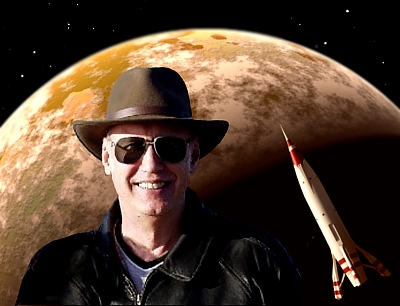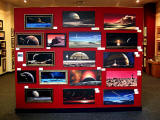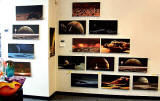|
 Frank
Hettick, was born in 1937 in Tillamook, Oregon. Like so many
other space artists of his generation, his interest in space and
astronomical art began at age13 when he received a copy of "The
Conquest Of Space", by Willy Ley and Chesley Bonestell. Those
fantastic illustrations encouraged Frank to begin drawing his
own space scenes. Frank
Hettick, was born in 1937 in Tillamook, Oregon. Like so many
other space artists of his generation, his interest in space and
astronomical art began at age13 when he received a copy of "The
Conquest Of Space", by Willy Ley and Chesley Bonestell. Those
fantastic illustrations encouraged Frank to begin drawing his
own space scenes.
Soon thereafter, he enrolled in the high
school art classes and began painting, first in tempera then in
oils. Frank recalls that being the second-tallest boy in high
school forced him onto the basketball team, but he soon gave
that up to spend more time on his part-time jobs – but he
remembers also working on his space art until "one or two in the
morning" after which he would sleep for a few hours before
arising to start the whole schedule over again.
By graduation in 1955 he had completed several dozen oil
paintings. His first commercial encouragement came when he
mailed two simulated "Weird Science" covers to the publisher in
New York. A couple of weeks later he opened a letter from the
editor, Al Feldstein, who congratulated him and stated how
pleased they were with his efforts.
Despite those kinds of encouragements Frank recognized the
necessity of earning a "real" living and soon became the
youngest real estate appraiser in Oregon. After spending almost
a dozen years with the State Department of Revenue in five
different Oregon counties as a commercial-industrial appraiser
he moved to a career in the private sector.
His efforts in commercial real estate development resulted in
several large shopping center and retail projects. In 1971 he
accepted a position with a Chicago publisher, wrote a book then
traveled through North and Central America conducting seminars
and lectures.
In 1976 he and his wife, Shirley, began a part-time company
to design and manufacture instruments for antique show cars,
street rods, movie cars, and classic boats. The small company
began simply to solve the problem of finding dashboard gauges
for Frank and some of his car friends for the hobby cars they
were building. Just one year later they moved to full-time and
within a few years the company had grown to become the leader in
specialty automotive instrumentation worldwide.
In 2001 Frank and Shirley sold their instrument company and
considered retirement – but soon after their former company had
been moved to Michigan they began to wonder what they could do
with the 4,000 square-foot like-new carpeted and air-conditioned
building.
"I have always tended to be a buyer and not a seller – so I
was not really inclined to sell the building as we still had a
lot of stuff stored in the back room and a lot of artwork
hanging on the walls! And where would we put all that stuff if
we sold the building?" Frank remembers. "Standing there and
looking at each other we both said ‘Now What?’"
It seemed the perfect solution – get the stuff out of storage
(Frank calls it "collectibles"), put in some display fixtures,
and open a gallery - now known as Sky-High Gallery and a prime
source of Frank’s space art works.
And some of those ‘collectibles’ at Sky-High Gallery are just
that!
How about the original prototype (made of wood) of the von
Braun-designed Mars Liner that he and Walt Disney personally
approved in the early 1950s’ before Tomorrow Land was built? Or
how about one of the very detailed prop ‘Grail Diaries’ from
‘Indiana Jones and The Last Crusade’? Or how about a signed copy
of ‘The Exploration of Mars’ by Willy Ley (illustrations by
Bonestell) and Chesley Bonestell’s personal reference copy of
‘Space Travel’?
Frank even has the original ‘Weird Fantasy’ covers he did in
1951 – along with the ‘thank you’ letter he received from Al
Feldstein.
When Frank and Shirley had discussed retirement years before
Frank had said he wanted to restart his long-delayed art
efforts. Having only done a few catalog covers and some personal
art pieces during their long intensive career at raising a
family (three daughters now spread worldwide) and making their
former company successful – he now wanted to ‘prove, perhaps
just to myself, that I could still paint’!
"And I had collected all these tools of the trade – oil
paints, easels, drafting table, brushes, mediums, and canvas’s
just waiting for myriad space pieces to pop out of the surface –
and I had really been anxious to get started again." Frank
notes, "My mind was just filled with scenes I had been
storing up for some 40 years – and I wanted to get to it!
"To make my efforts a bit easier – and faster – I decided I
would lay out my initial compositions in the computer, adjusting
the perspective and lighting, shading, etc. Then once I had
gotten all the ‘mechanical’ things correct I would print out
‘the sketch’ and paint from that!
|
 |
I
was fortunate to be able to attend the press-preview showing
of Star Wars the same week in 1977 that it was scheduled to
open nationwide! As you can see from this picture - it is
over a quarter-of-a-century later but I am still hard at
work saving one galaxy after another - even though I should
have retired in 2002 - or was that 3002
Frank recalls that "I soon found that putting just a bit
more effort into the computer ‘sketch’ I could achieve something
very close to a final artwork without putting in days and weeks
waiting for the oils and canvas to dry and with the side benefit
of not having the chemical smells, messy cleanups, and all the
health hazards that we now know always accompany traditional
painting"!
"Soon I was spending more and more time at the computer
‘tweaking’ those ‘sketches’ until they looked just right! I soon
accumulated several dozen that I wanted to turn into finished
space art ‘paintings’. But several friends noted the ‘sketches’
were very ‘professional-appearing’ and could pass for ‘finished
art pieces’. I then determined that I would take some of my
sketches on to the ‘almost finished’ stage and finally complete
the painting by hand.
"Printing many of my pieces on canvas was the real
breakthrough! With the canvas being completed by hand painting
(mostly with acrylics to hasten drying time) the finished piece
is a close runner-up to a ‘totally done by hand’ piece. While
some persons still abhor any piece that is accomplished
partially by computer – most artists today appreciate that the
computer and software is only a tool!
Frank points out that "Composition, color, matched
lighting, perspective, and theme are all things that must be
accomplished by the individual artist since a computer has no
talent in these areas. I have always been a stickler for detail
(probably brought on by exposure to those early photo-realistic
scenes by Bonestell) and the computer has proven to be a very
beneficial tool in my attempts to picture those scenes that
perhaps no human will ever see – excepting through my efforts."
Although Frank has no driving ambition towards a commercial
reputation in space art, he has had several magazine covers and
TV-appearances. In the winter of 2002, Frank’s "Exploration"
space art piece made the Pulsar cover. In August of 2003 his
"Martian Odyssey" painting appeared on the BBC’s ‘The Sky At
Night’ program, during an interview with David Hardy.
Frank’s
artwork of "Sunrise Over Saturn" was selected for cover of The
Planetary Report, March – April 2004 issue. In August 2004
Frank's "A View Of Home" won First Place Award in an
international competition for The 7th Annual Mars Society
Conference in Chicago. The winning artwork was printed on the
Conference directory, the event t-shirts and was auctioned off
at the conference banquet. Frank hopes, through his space art,
to
encourage people to find the same sense of awe and wonder that
he has in our universe!
Frank concludes "Being retired and without the need to
bring home a paycheck every month allows me the freedom to
remember the hope I had for space exploration in my formative
years! I know the space ship designs and exploration methods
have not always turned out the way we had envisioned in those
early years but I do believe that period was a time of
excitement, wonder, encouragement, challenge, and lofty goals! I
want to recapture those times and views in such a way that our
grandchildren may share in the excitement I had growing up in
the 1950’s – and I want to do it in a way that people will look
at my stuff someday and say ‘Is that the way it really is?
Maybe, ‘That’s not the way it really is - but it sure looks
real!’" or ‘It really doesn’t look that way – but it
certainly should have!" like so many of us said about
Bonestell’s moonscape treatment after viewing the Apollo
photographs!"
Frank Hettick says he will be very satisfied with that!
Update:
November 6th & 7th, 2004, Frank Hettick had a one-man show
at the Ernst & Ernst Collectors Gallery in Seaside Oregon. He
had to finish 32 pieces on canvas, sign and number and enhance
with acrylics for the show. He sold four pieces during the two
day event. Within the next few weeks the pieces at the gallery
will be divided between two galleries - Ernst in Seaside and
Ernst Gallery in Cannon Beach Oregon.
The owner plans another show with Frank this summer. He also
wants to include one on Frank's originals in an
"all-original-only" show. The other 15 artists includes Alan
Bean.
Gallery Website:
www.ernstgallery.com



Click for larger view.
Update: Frank Hettick received notification
that his artwork for The Planetary Society's Huygens Art
Contest: "Imagining Titan: Artists Peer Beneath the Veil", won
first prize. You can visit at:
http://planetary.org/saturn/contest/frank_hettick.html

Click for larger view.
|